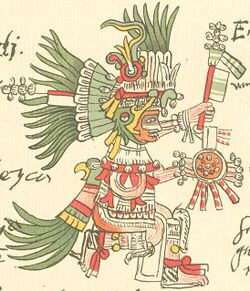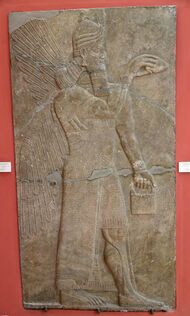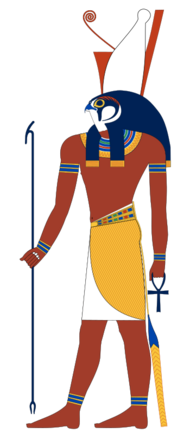Unsolved:List of avian humanoids
From HandWiki
Short description: Wikipedia list article
Avian humanoids (people with the characteristics of birds) are a common motif in folklore and popular fiction, mainly found in Greek, Roman, Manipuri, Hindu, Persian mythology, etc.
Folklore
- Alkonost from Russian mythology
- Almost all of the Anemoi, best depicted on the Tower of the Winds
- Angels in all Abrahamic religions, though mainly in artistic depictions
- Anzû from Mesopotamian mythology, either a lesser divinity or a monster
- Arke, Iris' sister who also had wings,[1] said to be iridescent
- Ba, the part of a human's soul that roughly represents its personality, depicted as a bird with a human head[2]
- Calais and Zetes, sons of the North Wind Boreas[3]
- Chareng-Aka Uchek Langmeidong, it is a mythical creature, from Manipuri mythology in the form a semi human and semi hornbill, with an avian body and a human head.
- The Ekek in Philippine mythology is depicted as a humanoid with bird wings and a beak
- Eos is often depicted as winged in art[4]
- Eris (mythology) was depicted as winged in ancient Greek art[5]
- Eros/Cupid is often depicted as winged[6]
- The Faravahar of Zoroastrianism
- Gamayun from Russian mythology
- Gandharvas, skilled musicians from Hinduism who can appear as part man and part bird[citation needed]
- The Garuda, eagle-man mount of Vishnu in Hindu mythology, was pluralized into a class of bird-like beings in Buddhist mythology.[7][8][9]
- Geryon, a giant defeated by Hercules who, in one account, was described as having wings[10][11] and some mid-sixth-century Chalcidian vases portray him as winged
- Harpies, bird-women associated with storm winds known for terrorizing mortals[12][13]
- The gods Horus and Thoth from ancient Egyptian mythology were often depicted as humans with the heads of a falcon[14] and an ibis,[15] respectively.
- Huitzilopochtli, "hummingbird's south" or "hummingbird's left"; Aztec god of the sun and war who was often depicted as either a hummingbird or an eagle
- Iris (mythology) was said to have golden wings[16][17] with "golden-winged" as one of her epithets and was often depicted in art as having wings[18]
- Isis and her sister Nephthys were ancient Egyptian goddesses commonly depicted with kite (bird) heads or wings attached to their arms[19][20]
- The Kinnara and Kinnari in southeast Asia are two of the most beloved mythological characters, who are benevolent half-human, half-bird creatures
- Karura in Japanese folklore
- Lamassu from Mesopotamian mythology, a winged protective deity
- Lei Gong, a China thunder god, often depicted as a bird man[21]
- Langmeidong-It is a mythology creature from Manipuri mythology, in the form of a semi human, semi hornbill, with an avian body and a human head.
- The second people of the world in Southern Sierra Miwok mythology[22]
- Morpheus, son of Hypnos and a god of dreams[23]
- Neith, Egyptian goddess sometimes portrayed as having bird wings attached to her arms[24][25]
- Nemesis was described as winged by Mesomedes[26] and is often portrayed as such in art
- Nightingale the Robber in Slavic folklore, who is killed by the hero Ilya Muromets[27]
- Nike is very famous for her birdlike wings[28]
- Pamola, a bird-man from Abenaki mythology[29]
- Peri, beautiful, winged women from Persian folklore
- Ra, an ancient Egyptian sun god often depicted with a falcon's head[30]
- Sirens from Greek mythology started out as women-bird hybrids,[31] but later evolved to become closer to mermaids
- Sirin, Russian take on the siren that's closer to their original depiction as birds
- The swan maidens in the folktales of cultures such as Sweden, Germany, Romania, Serbia, Japan, and Pakistan[32]
- Tangata manu of Easter Island,[33] often depicted as a frigate bird/human hybrid
- The Tengu of Japanese folklore, monstrous forest and mountain dwelling humanoids often possessing the wings, claws, and sometimes the beak of a bird.[34]
- Thanatos and his brother Hypnos were often portrayed as winged[35]
- "Uchek Langmeidong"-In Kanglei mythology, it is a mythical creature, semi human, semi hornbill, with an avian body and a human head. The bird is a form of a hornbill bird.
- Wayland the Smith from Germanic mythology; scholars differ on whether they think he organically grew wings to escape imprisonment or fashioned artificial ones like Daedalus
- Winged genie, recurring motif in Assyrian art; they're bearded men with birds' wings
Fiction
- The Chozo civilization, a highly intelligent and technologically advanced bird-like species in the Metroid series.[36]
- The winged people of Normnbdsgrsutt in Robert Paltock's utopian fantasy Peter Wilkins (1750), including Youwarkee, whom Peter marries.[37]
- The Flock from James Patterson's Maximum Ride novel series.
- The bird people of Brontitall, led by The Wise Old Bird, in The Hitchhiker's Guide to the Galaxy are depicted by Douglas Adams as evolving from humans who are so sick of buying shoes that they become bird-like creatures and never set foot on the ground again (see Shoe Event Horizon).
- The race of garuda in fantasy author China Miéville's world Bas-Lag as featured in Perdido Street Station.[38]
- In J.K. Rowling's Harry Potter series, a race of magical creatures called Veela appear as extraordinarily beautiful women, but turn into frightening bird-like creatures when angered.
- Vergere in The New Jedi Order book series in the Star Wars expanded universe is of the Fosh species, capable of producing tears that can be used as poison or healing.
- The Rito in The Legend of Zelda game series.
- The Shi'ar from Marvel Comics, a species of cold-blooded humanoids of avian descent; they resemble humans with feathered crests atop their heads in lieu of hair.
- The Illyrians from A Court of Thorns And Roses series by Sarah J. Maas. They are a warrior race of faeries living in the mountains. Illyrians have wings similar to bat wings.
- Birdperson, a character from the television series Rick and Morty, is a tall humanoid with two giant eagle wings. He is later renamed "Phoenixperson."
- Prince Vultan's hawkmen from the 1980 space opera film Flash Gordon.
- Turians from the Mass Effect series, a warrior race with avian features.[39]
- Arakkoas from the World of Warcraft expansions (first appearing in WoW: Burning Crusade), a bird humannoid race with avian features.
- Papi, a harpy from the manga series Monster Musume.
See also
References
- ↑ Ptolemy Hephaestion, New History Book 6 (summary from Photius, Myriobiblon 190) (trans. Pearse)
- ↑ Allen, James W. (2000). Middle Egyptian: An Introduction to the Language and Culture of Hieroglyphs. Cambridge, UK: Cambridge University Press. ISBN:978-0-521-77483-3.
- ↑ Apollonius, Rhodius (February 1, 1997). "The Argonautica". https://www.gutenberg.org/ebooks/830.
- ↑ "A Dictionary of Greek and Roman biography and mythology, Ea'rinus, Fla'vius, E'ntochus, Eos". https://www.perseus.tufts.edu/hopper/text?doc=Perseus:text:1999.04.0104:alphabetic+letter=E:entry+group=4:entry=eos-bio-1.
- ↑ commons:File:Eris_Antikensammlung_Berlin_F1775.jpg[circular reference]
- ↑ commons:File:Cassel_Painter_-_Kalpis_with_Toilette_Scene_with_Two_Women_and_Eros_-_Walters_4878_-_Side_A_Detail.jpg[circular reference]
- ↑ Robert E. Buswell Jr.; Donald S. Lopez Jr. (2013). The Princeton Dictionary of Buddhism. Princeton University Press. pp. 314–315. ISBN 978-1-4008-4805-8. https://books.google.com/books?id=DXN2AAAAQBAJ.
- ↑ Roshen Dalal (2010). Hinduism: An Alphabetical Guide. Penguin Books. p. 145. ISBN 978-0-14-341421-6. https://books.google.com/books?id=DH0vmD8ghdMC.
- ↑ Helmuth von Glasenapp (1999). Jainism: An Indian Religion of Salvation. Motilal Banarsidass. p. 532. ISBN 978-81-208-1376-2. https://books.google.com/books?id=WzEzXDk0v6sC&pg=PA532.
- ↑ Scholiast on Hesiod's Theogony, referring to Stesichoros' Geryoneis
- ↑ "GERYON (Geryones) - Three-Bodied Giant of Greek Mythology". https://www.theoi.com/Gigante/GiganteGeryon.html.
- ↑ Homer. Odyssey, Book 20.66 & 77
- ↑ Ovid. Metamorphoses vii.4
- ↑ Wilkinson, Richard H. (2003). The Complete Gods and Goddesses of Ancient Egypt. Thames & Hudson. p. 202.
- ↑ Budge, E. A. Wallis. The Gods of the Egyptians Volume 1 of 2. New York: Dover Publications, 1969 (original in 1904). Vol. 1 p. 401
- ↑ Homer, Iliad 8. 397 ff
- ↑ Homer, Iliad 11. 185 ff
- ↑ "A Dictionary of Greek and Roman biography and mythology, Iacchus, Irenaeus, Iris". https://www.perseus.tufts.edu/hopper/text?doc=Perseus:text:1999.04.0104:alphabetic+letter=I:entry+group=9:entry=iris-bio-1.
- ↑ Wilkinson, Richard H. (2003). The Complete Gods and Goddesses of Ancient Egypt. Thames & Hudson. ISBN:978-0-500-05120-7.
- ↑ Griffiths, J. Gwyn (1980). The Origins of Osiris and His Cult. Brill. ISBN:978-90-04-06096-8.
- ↑ "China: 'Master Thunder (Lei Gong)', a Ming Dynasty hanging silk scroll from 1542, Metropolitan Museum of Art, New York". AKG Images. https://www.akg-images.co.uk/archive/-2UMEBMYSU0QE7.html.
- ↑ S. A. Barrett (1919-03-27). "Myths of the Southern Sierra Miwok". University of California Publications in American Archeology and Ethnology 16 (1): 1–28. http://www.yosemite.ca.us/history/myths_of_the_southern_sierra_miwok/.
- ↑ Henderson, Jeffrey. "Book XI". https://www.loebclassics.com/view/ovid-metamorphoses/1916/pb_LCL043.167.xml.
- ↑ Jean-François, 1790-1832, Champollion (July 1, 2014). "English: Panthéon égyptien, collection des personnages mythologiques de l'ancienne Égypte, d'apres les monuments; / avec un texte explicatif par M. J. F. Champollion le jeune, et les figures d'apres les dessins de M. L. J. J. Dubois". https://commons.wikimedia.org/wiki/File:Neith_G%C3%A9n%C3%A9ratrice_(Ath%C3%A9n%C3%A8,_Physis,_Minerve),_N372.2_C35.jpg.
- ↑ commons:File:Diosa_Neit_(M.A.N.)-01.jpg[circular reference]
- ↑ "Mesomedes: Hymn to Nemesis (From Greek)". https://poemsintranslation.blogspot.com/2011/05/mesomedes-hymn-to-nemesis-from-greek.html.
- ↑ Bailey, James; Ivanova, Tatyana (1998). An Anthology of Russian Folk Epics. M.E. Sharpe. p. 27. ISBN 978-0873326414.
- ↑ "NIKE - Greek Goddess of Victory (Roman Victoria)". https://www.theoi.com/Daimon/Nike.html.
- ↑ "Home". https://www.penobscotnation.org/.
- ↑ Hart, George (1986). A Dictionary of Egyptian Gods and Goddesses. London, England: Routledge & Kegan Paul Inc. pp. 179–182. ISBN:978-0-415-05909-1.
- ↑ "SOL Search". https://www.cs.uky.edu/~raphael/sol/sol-cgi-bin/search.cgi?search_method=QUERY&login=&enlogin=&searchstr=sigma,280&field=adlerhw_gr&db=REAL.
- ↑ Ashliman, D. L. (2008). "Swan Maidens | Folktales of Type 400". https://www.pitt.edu/~dash/swan.html. "The myth of the Swan Maiden is one of the most widely distributed and at the same time one of the most beautiful stories ever evolved from the mind of man.--Edwin Sidney Hartland"
- ↑ Routledge, Scoresby, Mrs; Routledge, Katherine (1917). "The Bird Cult of Easter Island". Folklore 28 (4): 337-355. "An "iviatua," a divinely-gifted individual, dreamed that a certain man was favoured by the gods, so that if he entered for the race he would be a winner, or, in technical parlance, become a bird-man or " tangata manu"; it was also ordained that he should then take a new name, which formed part of the revelation, and this bird-name was given to the year in which victory was achieved, thus forming an easily remembered system of chronology.".
- ↑ de Visser, M. W. (1908). "The Tengu". Transactions of the Asiatic Society of Japan 36 (2): 25–99.
- ↑ "Euphronios Krater: The Continuing Saga (ca. 515 BC) - Ancient History Blog". https://ancientstandard.com/2007/08/30/euphronios-krater-the-continuing-saga-ca-515-bc/.
- ↑ "The Official Metroid Website". https://metroid.nintendo.com/news/metroid-dread-report-vol-7/.
- ↑ Paltock, R.; Bullen, A.H. (1884). The Life and Adventures of Peter Wilkins. The Life and Adventures of Peter Wilkins. Reeves & Turner. p. xvi and passim. https://archive.org/details/lifeandadventur01paltgoog. Retrieved 5 October 2018.
- ↑ "Perdido Street Station By China Miéville". Penguin Random House. https://www.penguinrandomhouse.com/books/114262/perdido-street-station-by-china-mieville/9780345443021/.
- ↑ Hudson, Casey; Watts, Derek (February 2, 2012). The Art of the Mass Effect Universe. Dark Horse Comics. ISBN 978-1-59582-768-5.
External links
- Cathy S. Mosley. ""The Princess of the Bird People" a retelling of "Manora, the Bird Woman," from Thailand". H-NILAS: Stories for the Seasons. http://www.h-net.org/~nilas/seasons/bpeople.html. — This cites Toth, Marian Davis (1971). Tales From Thailand. Tokyo: Charles E. Tuttle..
- Zerah'el Dancing Grouse. "The Story of the Bird People". Free Cherokee. http://www.freecherokee.org/birds/birdpeople.htm. — a story from a story teller of the Bird Clan of East Central Alabama that parallels the evolution of birds from dinosaurs





